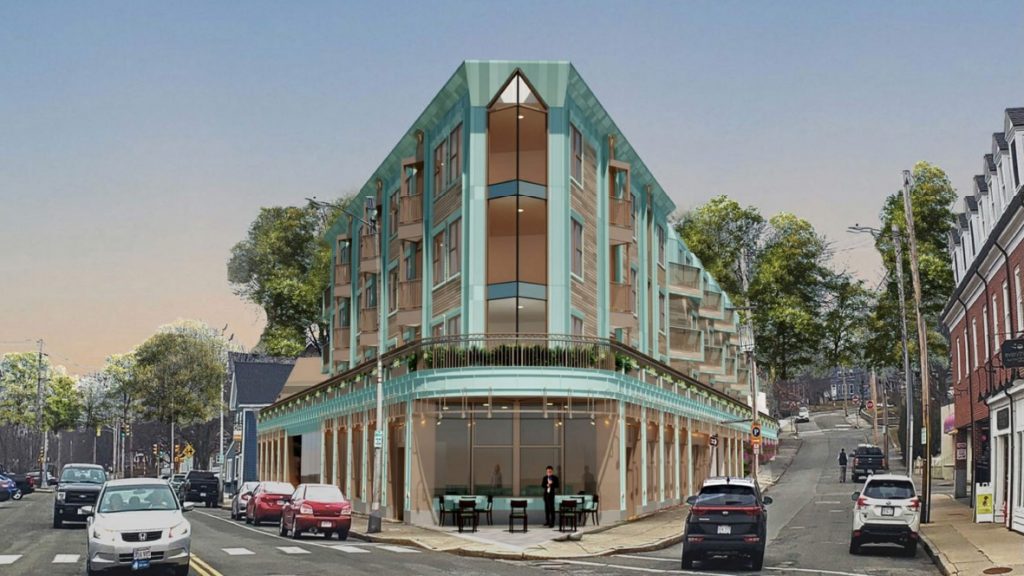Reading, MA — The public hearing to review plans for a proposed new four-story development at 6-16 Chute Street was reopened by the Community Planning and Development Commission on January 24. The current building on the 17,986 square foot site, built in 1974, is a one-story commercial building that houses several businesses, including the Last Corner Restaurant, The Green Tomato, and a laundromat.

The proposed building would create two commercial spaces on the first floor facing High Street with an enclosed parking garage for residents, also on the first floor. The garage would be accessed via a Chute Street entrance. The upper three floors would house thirty-one apartments. Twenty-five percent of those apartments would be designated as “affordable.” Entrances to the residential portion of the building would also be both on High Street and on Chute Street.
Project Architect Jeffrey Olinger shared changes that have been made to the plan since the December 13 meeting. A transformer has been moved from the High Street side of the building to inside the parking garage, creating space for a small plaza that could be utilized by one of the retail spaces. The upper cornice of the building has been reduced in size to bring the entire building height under forty-five feet. Olinger explained that due to this change, the project would no longer need a height waiver from the CPDC.
Olinger continued to describe a slight mansard shape of the roofline on the fourth floor of the building, which aids in reducing the appearance of massing. Also, balconies have been added to the units on the Chute Street side. A different contrasting color of “infill” will be used on a portion of the Chute Street side as well, which Olinger believes will also break up the massing. Olinger described that the front of the building will now be convex in shape, adding over 100 square feet of open space to the public area in the triangle-shaped front portion of the property. Olinger continued, mentioning that a public easement could be granted in a part of that space for the town to develop as it sees fit. CPDC chair Pamela Adrian described the changes as “a bit of nip and tuck here and there.”
Discussion opened as CPDC member Nick Safina offered questions about the number of units in the building, which is seventy-five per acre, according to Town of Reading Development Director Julie Mercier. “I asked you [at the first presentation in August 2021] to defend the number of units, not the size of the building,” Safina stated.
Attorney Josh Latham, speaking for developer Plimsoll Companies, shared that the 40R overlay district was intended to promote development in areas where greater density makes sense. He then described this proposal as “the most ideal for 40R [in the downtown.]” and “an improvement of a tired site.” Safina responded that Latham’s answer was philosophical in nature and did not present him with any facts as to why there need to be thirty-one units in the building and not twenty-five or twenty-eight. CPDC member Heather Clish responded with similar questions asking for “concrete” information regarding the need for the project’s density.
Several residents spoke, asking about reducing the building height by one floor, the effect the project will have on the sidewalk on High Street, and asking for more open space at the triangle “tip” of the site. Resident Matt Hasselton expressed concerns over the lack of a “New England feel” that he believes the project lacks and concern over the businesses housed in the current building. Resident Liz Whitelam spoke in favor of the project, stating that as a downtown business owner, she believes that the 40R mixed-use model is “helpful in creating a vibrant downtown.” Residents Sarah Brukilacchio and Bernie Horn expressed concerns regarding residential and commercial parking in the area.
CPDC continued the public hearing to February 28 at 7:30 pm, instructing the developer to either reduce the units per acre to the 55-60 range or provide “significant” justification for why the lower density building could not work financially or otherwise.
CPDC voted 4-0-1 to approve forms H and K for a previously approved subdivision at 135-139 and 149 Howard Street. It closed the public hearing and delayed action on bylaw amendments regarding the floodplain overlay district as, according to Mercier, new requirements will be addressed in 2023.
CPDC voted 5-0 to approve a certificate of appropriateness for a sign to be installed over the residential entrance to “The Chronicle” building at the corner of Main Street and Chapin Avenue. It also continued a public hearing to February 7 at 8:00 pm regarding the master signage plan for the Postmark building on Haven Street. This includes four signs for three businesses on the site, one on the side of the former post office building wall for DiBiase Companies, one freestanding sign for the Common District Meeting House in a landscaped area at the front of the building, and one wall sign and one blade sign for Classified Realty in the newly constructed space in the lower portion of the building. Concerns were expressed related to the size of the Common District Meeting House sign and whether or not a blade sign was the best use for a second sign at Classified Realty.
CPDC concluded with a continued discussion and public hearing regarding possible amendments that could be made to the 40R bylaw.
